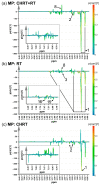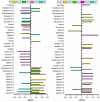Metabolite Biomarkers of Prolonged and Intensified Pain and Distress in Head and Neck Cancer Patients Undergoing Radio- or Chemoradiotherapy by Means of NMR-Based Metabolomics-A Preliminary Study
- PMID: 38248863
- PMCID: PMC10819132
- DOI: 10.3390/metabo14010060
Metabolite Biomarkers of Prolonged and Intensified Pain and Distress in Head and Neck Cancer Patients Undergoing Radio- or Chemoradiotherapy by Means of NMR-Based Metabolomics-A Preliminary Study
Abstract
Treatment of head and neck squamous cell carcinoma (HNSCC) has a detrimental impact on patient quality of life. The rate of recognized distress/depression among HNSCC patients ranges from 9.8% to 83.8%, and the estimated prevalence of depression among patients receiving radiotherapy is 63%. Shorter overall survival also occurs in preexisting depression or depressive conditions. The present study analyzes the nuclear magnetic resonance (NMR) blood serum metabolic profiles during radio-/chemoradiotherapy and correlates the detected alterations with pain and/or distress accumulated with the disease and its treatment. NMR spectra were acquired on a Bruker 400 MHz spectrometer and analyzed using multivariate methods. The results indicate that distress and/or pain primarily affect the serum lipids and metabolites of energy (glutamine, glucose, lactate, acetate) and one-carbon (glycine, choline, betaine, methanol, threonine, serine, histidine, formate) metabolism. Sparse disturbances in the branched-chain amino acids (BCAA) and in the metabolites involved in protein metabolism (lysine, tyrosine, phenylalanine) are also observed. Depending on the treatment modality-radiotherapy or concurrent chemoradiotherapy-there are some differences in the altered metabolites.
Keywords: HNSCC; chemotherapy; distress; metabolomics; pain; radiotherapy.
Conflict of interest statement
The authors declare no conflicts of interest.
Figures





Similar articles
-
Metabolomic Insight into Implications of Induction Chemotherapy Followed by Concomitant Chemoradiotherapy in Locally Advanced Head and Neck Cancer.Int J Mol Sci. 2023 Dec 22;25(1):188. doi: 10.3390/ijms25010188. Int J Mol Sci. 2023. PMID: 38203359 Free PMC article.
-
NMR-Based Metabolomics in Investigation of the Radiation Induced Changes in Blood Serum of Head and Neck Cancer Patients and Its Correlation with the Tissue Volumes Exposed to the Particulate Doses.Int J Mol Sci. 2021 Jun 11;22(12):6310. doi: 10.3390/ijms22126310. Int J Mol Sci. 2021. PMID: 34208417 Free PMC article.
-
NMR-Based Metabolomics of Blood Serum in Predicting Response to Induction Chemotherapy in Head and Neck Cancer-A Preliminary Approach.Int J Mol Sci. 2024 Jul 10;25(14):7555. doi: 10.3390/ijms25147555. Int J Mol Sci. 2024. PMID: 39062797 Free PMC article.
-
NMR-based metabolomics in real-time monitoring of treatment induced toxicity and cachexia in head and neck cancer: a method for early detection of high risk patients.Metabolomics. 2019 Aug 16;15(8):110. doi: 10.1007/s11306-019-1576-4. Metabolomics. 2019. PMID: 31420744 Free PMC article.
-
Evolving role of novel radiosensitizers and immune checkpoint inhibitors in (chemo)radiotherapy of locally advanced head and neck squamous cell carcinoma.Oral Oncol. 2023 Oct;145:106520. doi: 10.1016/j.oraloncology.2023.106520. Epub 2023 Jul 17. Oral Oncol. 2023. PMID: 37467684 Review.
Cited by
-
Pain, lactate, and anesthetics: intertwined regulators of tumor metabolism and immunity.Front Oncol. 2025 Mar 17;15:1534300. doi: 10.3389/fonc.2025.1534300. eCollection 2025. Front Oncol. 2025. PMID: 40165895 Free PMC article. Review.
References
-
- Henry M., Rosberger Z., Bertrand L., Klassen C., Hier M., Zeitouni A., Kost K., Mlynarek A., Richardson K., Black M., et al. Prevalence and Risk Factors of Suicidal Ideation among Patients with Head and Neck Cancer: Longitudinal Study. Otolaryngol. Head Neck Surg. 2018;159:843–852. doi: 10.1177/0194599818776873. - DOI - PubMed
LinkOut - more resources
Full Text Sources

